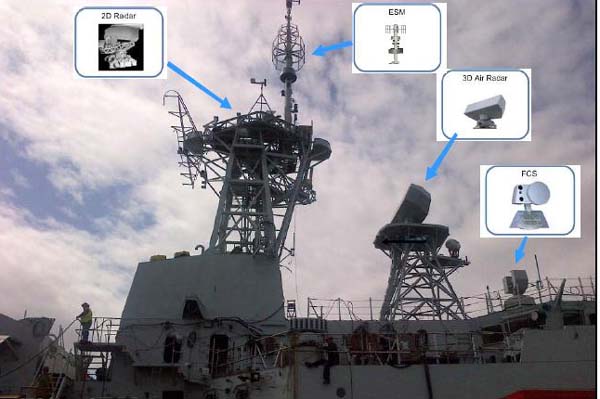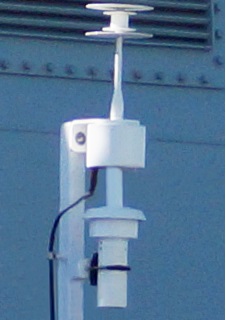The Defence Industry Daily web site provides a summary of the
Halifax class modernization program.
Canada’s government has decided to fund that modernization,
much as Australia and New Zealand are modernizing the Halifax Class’ ANZAC
Frigate contemporaries. Refits are scheduled to begin with HMCS Halifax
in 2010, and that ship is scheduled to re-enter service about 18 months
later in 2012. By 2017, all 12 frigates are scheduled to be upgraded as
part of a C$ 3.1 billion (about $2.9 billion) program.
This DID article explains the scope of the upgrades, notes the current
systems, and covers the contracts and developments involved…
Upgrading The Halifax Class
Upgrades will be conducted through Canada’s FELEX (Frigate Life Extension)
program. FELEX will manage all work elements in the modernization program,
to varying degrees, as the project’s overall Design Integration Authority.
The FELEX program is responsible for the ship level design integration
including any unique/specific engineering changes required. It is also
responsible for effective risk mitigation via scope management, design
integration engineering, integrated risk management across all elements
of the HCM, schedule coordination, and implementation/installation management.
Some projects will be conducted wholly within FELEX, while others will
be stand-alone projects that receive independent funding. Still others
will be rolled into the ships’ maintenance efforts. Integral FELEX Projects
include:
Internal Communications System Upgrade.
This is also being done to a number of American ships, who are replacing
their copper wiring and installing fiber optics and gigabit Ethernet to
go with their network and SATCOM hardware upgrades. The ships’ current
Communications Control and Monitoring System (CCMS) was supplied by SED
Systems of Saskatoon, with a message processing system from Lockheed Martin
Electronic Systems Canada.
Harpoon Missile System Upgrade
Halifax Class ships currently carry 8 BGM-84 Block IC anti-ship missiles
each. Boeing’s Harpoon Block II adds GPS guidance, much better near-shore
capability, and land attack options.
Electronic Warfare System upgrade –
Electronic Support Measures. Currently the SLQ-501
Canews (Canadian Electronic Warfare System), and SLQ-505 radar jammer.
Semi-independent (sovereignty-association?) projects include:
MODERNIZED COMMAND AND CONTROL SYSTEM
The Halifax class ships currently use the SHINPADS integrated processing
and display system supplied by Lockheed Martin Canada, each using about
15 AN/UYK-501 workstations manufactured by General Dynamics Canada. They
will be replaced with Lockheed Martin and Saab Systems 9LV system, a popular
combat system used around the world in classes ranging from Sweden's ultra-modern
Visby corvettes to Australia’s forthcoming Canberra Class LHD amphibious
landing ships. The 9LV provides a core element of the Lockheed Martin Halifax
Class Modernization (HCM) Team’s Canadian Advanced Command
and Control System, or “CanACCS-9LV.”
RADAR UPGRADES
The current set includes two Thales Nederland SPG-503 (STIR 1.8) fire
control radars, Raytheon's SPS-49v5 long-range active air search radar
operating at C and D bands, Saab Microwave Systems HC150 Sea Giraffe medium-range
air and surface search radar operating at G and H bands.
IRIUS – Long-range infrared search and track system.
Important for near-shore surveillance, and ships operating under low-emissions
restrictions. IRST on ships is specially useful against small surface targets,
low flying aircraft, and anti-ship missiles. Its TV images are especially
useful for threat classification. DRS Canada and Thales Nederland won with
their Sirius system
ESSM – Evolved Sea Sparrow Missile.
The frigates currently carry 16 RIM-7 Sea Sparrow missiles, which cannot
cope with modern threats. Raytheon’s RIM-162 ESSM is an entirely new missile
that has become the new NATO standard, with substantially better maneuverability
and capability against low-flying targets. IFF Mode S/5. Identification
Friend-or-Foe technology is not foolproof, but if it fails, the results
can be tragic. IFF Mode 5 offers new algorithms that improve performance,
encryption, range, and civil compatibility. It also adds “lethal interrogation”
as a must-respond last chance, and the ability to see individual aircraft
even when they’re close together. The further addition of IFF Mode S assigns
a discrete ‘squawk’ which is unique to each aircraft.
Maintenance projects will include:
Replacement of the ships’ Integrated Machinery Control System.
Unspecified modifications to the Saab Bofors 57mm naval gun. The most
modern 57mm guns offer substantially better capabilities against targets
like helicopters, small boats and UAVs, and can even be used in a last-ditch
defensive role against anti-ship missiles.
Replacement of the BAE Systems Shield Mk2 missile decoy launchers, which
fire chaff to 2 km and infrared rockets to 169m in distraction, confusion
and centroid seduction modes. In 1997, Canada ordered Nulka hovering decoy
systems from BAE Australia, to equip its 4 aged Tribal/Iroquois Class destroyers.
Nulka is also used by Australian and US Navy ships.
Replacement of the current Kelvin Hughes Type 1007 I-band navigation
radar.
A pair of important projects aren’t conducted by Canada’s Navy, but
the Navy will have to make sure they can work with the Halifax Class ships.
The new CH-148/H-92 Maritime Helicopter will replace the existing CH-124
Sea King Fleet, and a new Military Satellite Communication System will
offer greatly improved bandwidth and performance.
Respected defense journalist David Pugliese of the Ottawa Citizen notes
that: “Most of the industry folks that I have talked to acknowledge that
this [18 months per ship, complete by 2017] is a tight and aggressive schedule
considering the amount of work that needs to be done.”
 |
| From Your Navy Today: On the mainmast (situated to the left in the
picture), the platform upon which the new two-dimensional long-range air
search radar is mounted, is clearly evident, as are the Electronic Warfare
antennae mounted to the right. Such antennae generally operate / exploit
frequencies that require them to be positioned as high as possible in a
warship, as a means of extending their working horizon.
Moving forward (to the right in the picture) is the frigate’s new three-dimensional
radar (so-called as it will provide range, bearing and height information
on detected air tracks) in the foremast to the right. Also just visible
is the ship’s new fire control system, immediately ahead of the 3D radar. |
 |
| This is the sensor assembly for the new meteorological system aboard
HMCS Vancouver A detailed document
on
it can be found here. (Photo by John Webber) |
On November 25/14, Defence Minister Rob Nicholson announced the successful
modernization of the first four Halifax-Class frigates. They are: HMCS
Halifax, Fredericton, Calgary, and Winnipeg. The program has remained on
budget and is scheduled to be completed by 2018, according to the Department
of National Defence.
RADIO
The date of this announcement is unknown, however the 721 image is dated
June 2010. Since this announcement is somewhat general, it is believed
the RCN fleet was retrofitted with this radio.
"Eight-five Rockwell Collins 721S radios were recently delivered to
the Royal Canadian Navy. Rockwell Collins recently provided enhanced networking
communication capability to the Royal Canadian Navy fleet by completing
delivery of the company’s 721S radios.
“The 85 radios, delivered on-time and on-budget, will enable the RCN
to fit their main combatants and allow them to take full advantage of the
wideband data throughput of their SNR systems,” said Alan Prowse, vice
president and managing director for the Americas for Rockwell Collins.
“The RCN is a strong supporter and early adopter of the Canadian-developed
SNR capability, which is now fielded internationally.” Prowse added that
the Royal Canadian Navy is the latest in a series of militaries to acquire
the 721S radio for naval operations. The growing popularity of the 721S
is largely driven by its proven ability to meet the throughput and data
needs of Rockwell Collins’ SubNet Relay system.
The 721S is among an elite class of radios designed and tested to operate
with SubNet Relay at data rates as high as 2 megabits per second in a 500
kilohertz channel, providing the advanced communications capability that
is required today.
The 721S radio, a drop-in, software-defined radio replacement for the
legacy Rockwell Collins AN/GRC-171 communications system, requires only
five minutes to install, weighs 60 percent less than its predecessor and
offers vastly improved capabilities. It is fully interoperable with legacy
radios in use by coalition forces and includes a new remote control feature
that allows customers to upgrade their installations for “lights out” operation,
reducing manpower needs. The radio also features Rockwell Collins’ patented
Clarity™ technology, which eliminates background noise in both transmit
and receive modes and provides four times the communications coverage compared
to legacy radios".
Select this link to
see the 721 specifications. Brochure courtesy Rockwell Collins.
From Janes. NOVEMBER 2023
Canada begins fitting ‘Strongbow' communications intel equipment on
frigates
by Richard Scott
The Royal Canadian Navy (RCN) has begun retrofitting an upgraded communications
eavesdropping suite on its 12 Halifax-class frigates under Project Strongbow.
Work has started on the implementation phase, according to Canada's
Department of National Defence (DND), with initial operational capability
(IOC) planned for 2025. Initial shipboard installations on three frigates
are following now-completed environmental qualification and software regression
testing.
Project Strongbow is designed to provide the RCN with an enhanced communications
direction finding (COMM DF) and signals intelligence (SIGINT) capability
by upgrading the existing AN/SRD-505 communications intelligence system.
The new system, designated AN/SRD-506, is to detect and analyse complex
radio signals.
The Strongbow project has an approved budget of CAD116 million (USD84.5
million). The main acquisition contract was let in 2020 to Southwest Research
Institute (SwRI), the US-based original equipment manufacturer, reflecting
the fact that a significant portion of the legacy COMM DF fit is maintained.
For SIGINT technology, the upgrade was acquired non-competitively through
a government-to-government contract..
“Work is under way on the first installs to be completed on HMCS Toronto
, HMCS Calgary, and HMCS Halifax in 2025,” a DND spokesperson told Janes
on 9 November. “Supporting infrastructure for testing and trials at the
Naval Electronic Sensor Test Range (Atlantic/Pacific) will be implemented
in the spring 2025 timeframe to support initial sea acceptance trials.”
Upgrades are being performed during routine planned docking work periods
and extended work periods for the Halifax-class ships. “IOC is expected
in 2025, with all upgrades on the Halifax-class frigates expected to be
completed by the end of 2031,” the DND told Janes .


